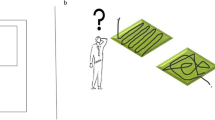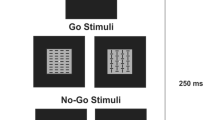Abstract
In this study, we investigated if the enactment of an approaching or avoiding behavior influences the mental rotation performance. Thirty-five females and thirty males completed a chronometric mental rotation task either in an approaching or in an avoiding condition while manipulating their arm position. The results showed a significant influence of this embodied behavior dependent on gender and task difficulty. The approaching condition caused no gender difference in reaction times and a reduced gender difference in accuracy for the most difficult tasks, while the avoidance condition produced the well-known gender differences in mental rotation for both reaction time and accuracy. We demonstrate that an approaching behavior improves the visual-spatial performance of females and gives a hint that the role of motivation must be investigated in more detail in further research.




Similar content being viewed by others
References
Amorim, M. A., Isableu, B., & Jarraya, M. (2006). Embodied spatial transformations: “Body analogy” for the mental rotation of objects. Journal of Experimental Psychology, 135, 327–347. doi:10.1037/0096-3445.135.3.327.
Bock, O. L., & Dalecki, M. (2015). Mental rotation of letters, body parts and scenes during whole-body tilt: Role of a body-centered versus a gravitational reference frame. Human Movement Science, 40, 352–358. doi:10.1016/j.humov.2015.01.017.
Delgrado, A. R., & Prieto, G. (2004). Cognitive mediators and sex-related differences in mathematics. Intelligence, 32, 25–32. doi:10.1016/S0160-2896(03)00061-8.
Devlin, A. L., & Wilson, P. H. (2010). Adult age differences in the ability to mentally transform object and body stimuli. Aging, Neuropsychology, and Cognition: A Journal on Normal and Dysfunctional Development, 17, 709–729. doi:10.1080/13825585.2010.510554.
Förster, J., Friedman, R. S., Özelsel, A., & Denzler, M. (2006). Enactment of approach and avoidance behavior influences the scope of perceptual and conceptual attention. Journal of Experimental Social Psychology, 42, 133–146. doi:10.1016/j.jesp.2005.02.004.
Friedman, R. S., & Förster, J. (2002). The influence of approach and avoidance motor actions on creative cognition. Journal of Experimental Social Psychology, 38, 41–55. doi:10.1006/jesp.2001.1488.
Friedman, R. S., & Förster, J. (2000). The effects of approach and avoidance motor actions on the elements of creative insight. Journal of Personality and Social Psychology, 79, 477–492. doi:10.1037//0022-3514.79.4.477.
Heil, M., & Jansen-Osmann, P. (2008). Sex differences in mental rotation with polygons of different complexity: do men utilize holistic processes whereas women prefer piecemeal ones? The Quarterly Journal of Psychology, 61, 683–689. doi:10.1080/17470210701822967.
Hengstler, M., Holland, R. W., van Steenbergen, H., & van Knippenberg, A. (2014). The influence of approach-avoidance motivational orientation on conflict adaptation. Cognitive, Affective, and Behavioral Neuroscience, 14, 548–560. doi:10.3758/s13415-014-0295-6.
Jansen, P., & Kaltner, S. (2014). Object based and egocentric mental rotation performance in older adults: the importance of gender differences and motor ability. Aging, Neuropsychology, and Cognition, 21, 296–316. doi:10.1080/13825585.2013.805725.
Jansen, P., Schmelter, A., Quaiser-Pohl, C., Neuburger, S., & Heil, M. (2013). Mental rotation performance in primary school age children: are there gender differences in chronometric tests? Cognitive Development, 28, 51–62. doi:10.1016/j.cogdev.2012.08.005.
Jansen-Osmann, P., & Heil, M. (2007). Suitable stimuli to obtain (no) gender differences in the speed of cognitive processes involved in mental rotation. Brain and Cognition, 64(217), 227. doi:10.1027/1618-3169.54.3.236.
Jola, C., & Mast, F. W. (2005). Mental object rotation and egocentric body transformation: two dissociable processes? Spatial Cognition and Computation, 5, 217–237. doi:10.1207/s15427633scc052&3_6.
Jolicoeur, P., Regehr, S., Smith, L. B. J. P., & Smith, G. N. (1985). Mental rotation of representations of two-dimensional and three-dimensional objects. Canadian Journal of Psychology, 39, 100–129. doi:10.1037/h0080118.
Kaltner, S., Jansen, P. (2014). Specific effects of fear and anxiety on mental rotation performance. Frontiers in Psychology: Emotion Science, 5, 792.
Kanoy, A., Brownlow, S., & Sowers, T. F. (2012). Can rewards obviate stereotype threat effects on mental rotation tasks? Psychology, 3, 542–547. doi:10.4236/psych.2012.37080.
Kessler, K., Rutherford, H. (2010). The two forms of visuo-spatial perspective taking are differently embodier and subserve different spatial preposition. Frontiers Psychology, 1, 213.
Kessler, K., Thomson, L. A. (2010). The embodied nature of spatial perspective taking: embodied transformation versus sensorimotor interference. Cognition, 114(1), 72–88. doi:10.1016/j.cognition.2009.08.015.
Koch, K., Pauly, K., Kellermann, T., Romanczuk-Seiferth, N., Reske, M., & Backes, V. (2007). Gender differences in the cognitive control of emotion: an fMRI study. Neuropsychologia, 45, 2744–2754. doi:10.1016/j.neuropsychologia.2007.04.012.
Laham, S. M., Kashima, Y., Dix, J., & Wheeler, M. (2015). A meta-analysis of the facilitation of arm flexion and extension movements as a function of stimulus valence. Cognition and Emotion, 29(6), 1069–1090. doi:10.1080/02699931.2014.968096.
Michelon, P., & Zacks, J. M. (2006). Two kinds of visual perspective taking. Perception and Psychophysics, 68, 327–337. doi:10.3758/BF03193680.
Moè, A. (2009). Are males always better than females in mental rotation ? Exploring a gender belief explanation. Learning and Individual Differences, 19, 21–27. doi:10.1016/j.lindif.2008.02.002.
Moè, A., Meneghetti, C., & Cadinu, M. (2009). Women and mental rotation: incremental theory and spatial strategy use enhance performance. Personality and Individual Differences, 46, 187–191. doi:10.1016/j.paid.2008.09.030.
Moè, A., & Pazzaglia, F. (2006). Following the instructions! Effects of gender beliefs in mental rotation. Learning and Individual Differences, 16, 369–377. doi:10.1016/j.lindif.2007.01.002.
Moè, A., & Pazzaglia, F. (2010). Beyond genetics in mental rotation test performance. The power of effort attribution. Learning and Individual Differences, 20, 464–468. doi:10.1016/j.lindif.2010.03.004.
Nussinson, R., Häfner, M., Seibt, B., Strack, F., & Trope, Y. (2012). Approach/avoidance orientations affect self-construal and identification with in-group. Self and Identity, 11, 255–272. doi:10.1080/15298868.2011.559044.
Oswald, W. D., & Roth, E. (1987). Der Zahlen-Verbindungs-Test (ZVT). Ein sprachfreier Intelligenz-Test zur Messung der „kognitiven Leistungsgeschwindigkeit“. Handanweisung (2nd ed.). Göttingen: Hogrefe.
Pazzaglia, F., & Moè, A. (2013). Cognitive styles and mental rotation ability in map learning. Cognitive Processing, 14(4), 391–399. doi:10.1007/s10339-013-0572-2.
Shepard, R. N., & Metzler, J. (1971). Mental rotation of three-dimensional objects. Science, 171, 701–703.
Smith, J. L., Sansone, C., & White, P. H. (2007). The stereotyped task engagement process: the role of interest and achievement motivation. Journal of Educational Psychology, 99(1), 99–114. doi:10.1037/0022-0663.99.1.99.
Steele, C. M., & Aronson, J. (1995). Stereotype threat and the intellectual test performance of African Americans. Journal of Personality and Social Psychology, 69, 797–811.
Steggemann, Y., Engbert, K., & Weigelt, M. (2011). Selective effects of motor expertise in mental body rotation tasks: comparing object-based and perspective transformations. Brain and Cognition, 76, 97–105. doi:10.1016/j.bandc.2011.02.013.
Vernon, P. A. (1993). Der Zahlen-Verbindungstest and other trail-making correlate of general intelligence. Personality and Individual Differences, 14, 35–40. doi:10.1016/0191-8869(93)90172-Y.
Voyer, D., & Jansen, P. (2016). Sex differences in chronometric mental rotation with human bodies. Psychological Research,. doi:10.1007/s00426-015-0701-x.
Voyer, D., Voyer, S., & Bryden, M. P. (1995). Magnitude of sex differences in spatial abilities: a meta-analysis and consideration of critical variables. Psychological Bulletin, 117, 250–270. doi:10.1037/0033-2909.117.2.250.
Wohlschläger, A., & Wohlschläger, A. (1998). Mental and manual rotation. Journal of Experimental Psychology: Human Perception and Performance, 24, 397–412. doi:10.1037/0096-1523.24.2.397.
Zacks, J. M., Mires, J., Tversky, B., & Hazeltine, E. (2002). Mental spatial transformations of objects and perspective. Spatial Cognition and Computation, 2, 315–332. doi:10.1023/A:1015584100204.
Acknowledgments
We would like to thank Daniel Lottes, Katharina Preischl und Saskia Venus for their help during data acquisition.
Author information
Authors and Affiliations
Corresponding author
Ethics declarations
Conflict of interest
All three authors declare that they have no conflict of interest.
Ethical approval
All procedures performed in studies involving human participants were in accordance with the ethical standard of the national research committee and with the 1964 Helsinki declaration and its later amendments or comparable ethical standards.
Informed consent
Informed consent was obtained from all individual participants included in the study.
Rights and permissions
About this article
Cite this article
Jansen, P., Kaltner, S. & Memmert, D. Approaching behavior reduces gender differences in the mental rotation performance. Psychological Research 81, 1192–1200 (2017). https://doi.org/10.1007/s00426-016-0817-7
Received:
Accepted:
Published:
Issue Date:
DOI: https://doi.org/10.1007/s00426-016-0817-7




